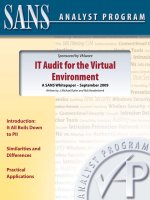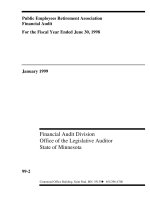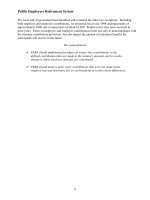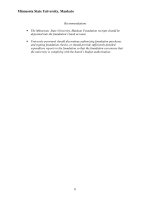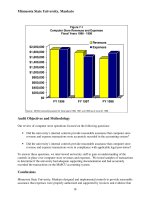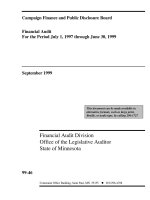IT Audit for the Virtual Environment: A SANS Whitepaper – September 2009 docx
Bạn đang xem bản rút gọn của tài liệu. Xem và tải ngay bản đầy đủ của tài liệu tại đây (374.98 KB, 13 trang )
Sponsored by VMware
IT Audit for the Virtual
Environment
A SANS Whitepaper – September 2009
Written by: J. Michael Butler and Rob Vandenbrink
Introduction:
It All Boils Down
to PII
Similarities and
Differences
Practical
Applications
SANS Analyst Program
1
IT Audit for the Virtual Environment
Introduction: It All Boils Down to PII
Industry requirements, government agency directives, and federal and state disclosure laws
(starting with California’s SB1386) have one goal in common:
Protect personal and private
information. It really doesn’t matter whether we are talking about credit card information,
bank account numbers, social security numbers, health data or insurance information. In fact,
instead of personal information, some organizations are focused on protecting utility infrastruc
-
tures, such as power plants, telecommunications, or gas lines. Although the information requir
-
ing protection in such a case is not “personal,” the same security and audit principles still apply.
So, to achieve compliance, IT groups check policies and procedures against rules, regulations,
and directives. They follow best practices and build defense-in-depth. IT auditors, SAS70
auditors, and PCI QSAs (Qualified Security Assessor) meet with the operations teams, whose
responses show that they are, indeed, compliant…that is, until we start talking about virtualiza
-
tion. In this realm, auditors are usually at a loss.
Virtualization is gaining popularity because of its promise of increased return on investment
(ROI) by reducing the data center footprint and power requirements. Gartner estimates that
more than four million virtual servers will be deployed by 2009, and that number will grow
to 660 million by 2011.
1
According to a recent SANS Log Management Survey of more than
700 IT professionals, 49 percent of respondents are currently collecting log data from virtual
machines, and 68 percent of those predict that, in 2010, nearly 70 percent of their logs will
come from virtual machines.
2
As organizations move ahead with their virtualization programs, they need to understand the
security and audit implications in the layers and features presented by virtual machine farms,
and their VMMs (virtual machine managers).
For starters, virtualization introduces a new layer known to most as Hypervisor, which is
VMware’s virtual machine manager. Virtualization also creates a new environment in which
virtual machine systems—connected via virtual network interfaces, virtual routers and virtual
switches and traversing virtual network paths—are dynamically moving around. In addition,
virtualization introduces new storage considerations around virtual drives, network storage
systems and fiber channels.
1
Gartner Research. “Gartner Says Virtualization Will Be the Highest-Impact Trend in
Infrastructure and Operations Market Through 2012,” April, 2008,
www.gartner.com/it/page.jsp?id=638207
2
Jerry Shenk. “SANS Annual 2009 Log Management Survey,” April, 2009,
www.sans.org/reading_room/analysts_program/logMgtSurvey_Apr09.pdf
SANS Analyst Program
2
IT Audit for the Virtual Environment
All these new layers, devices and traffic require management and protection just as they would
if they were physical machines and networks. But what do auditors need to know in order to
successfully locate and ensure secure processes around sensitive data traversing this new vir
-
tual environment?
Unfortunately, at this early stage of adoption, there is little guidance within the regulatory
frameworks on how to address new audit issues presented with virtualization. The purpose of
this paper is to help IT managers and auditors come together and understand the virtualiza
-
tion process and the new risk and audit areas this technology presents. It also offers guidance
on developing audit review processes that can be applied to virtualization, including how to
use virtualization to enhance audit processes.
For purposes of brevity, this paper will focus on PCI DSS audit in a VMware environment, which
is currently the most widely used virtualization platform. VMware’s own reports claim that
its ESX development platform is in use by 95 percent of the global fortune 500 companies.
3
According to CNN in January of this year, VMware had captured 85 percent of the market for
all virtualization implementations.
4
Although these principals are VMware and PCI DSS spe-
cific, they can be applied to most regulations/mandates, as well as to most enterprise virtual
environments.
3
www.vmware.com/technology/whyvmware/virtualization-customers.html
4
money.cnn.com/2009/01/19/technology/shambora_vmware.fortune/index.htm
SANS Analyst Program
3
IT Audit for the Virtual Environment
Similarities and Dierences
Virtual machines need to be secured and audited exactly as they are in physical network-server
environments. Such measures include the familiar procedures and checklists that we’ve used
all along: System hardening and security, change control, blocking of unauthorized equipment
and applications, network segmentation, monitoring, logging, alerting, and documentation
that supports audits of these processes.
The benefit of auditing in the virtual world is that virtual server farms are more centralized and
therefore more easily managed. As an example, PCI DSS addresses configuration and change
control applied to initial and final configurations. Because VMware is easily auditable using
scripts, audits for change can be done periodically, perhaps daily, with alarms to trigger on con-
figuration changes. These changes can then be compared to documentation indicating what
changes have been approved, and can also verify that approved changes occurred in agreed
upon maintenance windows.
There are many tools available to audit change control in a virtual infrastructure that will gen-
erally audit against the main regulatory framework requirements as well. They also include
their view of compliance to several frameworks, including: VMware Hardening Guide, PCI-DSS,
SOX, HIPAA, GLBA and ISO 17799 (in short, most frameworks except for JSOX).
In addition to commercial tools, VMware offers APIs and command line tools to permit audit
operations from Perl scripts from the ESX Service Console or vSphere command line interface.
Audits of overall environments are generally carried out using the Powershell APIs against the
vCenter “view of the world.” Audits using these tools can capture not only many of the ESX
specific controls, but also the controls that are only seen from vCenter, such as the impact of
VMotion (migration), HA (high availability) or FT (fault tolerance) on compliance or separation
of duties enforced through permissions on user accounts. However, some controls are best
assessed from the ESX hosts themselves. ESX Firewall settings, for instance, are not always
accurately reflected in the vCenter console, and should be assessed both from vCenter and
from the host itself (using the “esxcfg-firewall” command).
Finally, most of the information that is required for audit purposes is available by manually
navigating the vCenter console. However, there are two challenges in using this approach:
repeatability and formatting. Manual approaches to audit must be backed up with stringent,
documented manual processes to ensure that successive audits are actually assessing the
same controls in the same way. More important, collecting audit information manu-
ally forces auditors to create and format their audit from scratch, often manu-
ally transcribing information from a GUI screen or in some cases relying
on graphical screenshots. Such procedures can result in errors and/or
changes in audit metrics as the GUI changes across versions. More-
over, the manual procedures add significantly to the time required
to assemble an audit, when compared to basing an audit on text-
based information collected and preformatted by commercial
audit tools or script-based toolsets.
SANS Analyst Program
4
IT Audit for the Virtual Environment
Practical Applications
Practical applications of audit in virtual environments may vary depending on configuration
and interoperability issues. Despite these environmental differences, audit programs should
contain the following control areas:
Audit and Infrastructure Planning
The single largest issue with respect to PCI compliance is separation of virtual servers and
devices—and further separation from the guest operating system (i.e., PCI section 2.2.1). Sepa
-
ration of virtual server, switches, port groups on virtual switches, and separation of the guest
operating systems from the service console are clearly defined in the VMware Virtual Infra
-
structure.
However, these things are not spelled out in any current regulatory framework. This ambiguity
means that the easiest approach for auditors is to take the word “separate” to mean “separate
hardware,” and simply insist on separate servers or a separate physical servers to house data
that falls under PCI requirements. With proper segmentation, configuration and controls, how
-
ever, separate hardware should not be necessary.
PCI auditors often recommend PCI VLANs rather than separate hardware, because VLANs are well
understood by the QSA community. A PCI VLAN is considered by most to be a “separate enough”
network segmentation technique between virtual server farms, so long as the VLANs can pass
tests to indicate that appropriate controls are in place. Hopefully, the next version of the PCI-DSS
framework will offer a similar approach toward virtualized infrastructure segmentation.
It is important, however, to ensure that PCI compliance is maintained when the more advanced
features of virtual infrastructures are employed. For instance, VMotion, high availability (HA),
fault tolerance (FT), distributed resource scheduling (DRS), distributed power management
(DPM), and even basic system administration programs all have the ability to move a host to a
different network segment. Any of these moves can change the security posture of a host and
its associated PCI-governed data.
The PCI committee on virtualization is working on security guidance for virtual environments
that may be inserted in the next version of the PCI standard. Currently, however, such
guidance does not exist. If your company is planning a substantial financial
or project outlay for a virtual infrastructure, it’s a good idea to involve a
QSA (preferably your regular auditor or audit firm) provide a written
opinion on the infrastructure as part of the design process.
SANS Analyst Program
5
IT Audit for the Virtual Environment
Conguration
It is a common practice to create new virtual machines from gold images. These are VM images
that are completely installed and customized to a particular environment and security stan-
dard, which promotes a consistent, auditable server environment. However, there is a hidden
risk in this approach, which is the potential for misconfiguration of servers and systems as they
replicate, spin up, spin down and move around in the dynamic virtual environment. Standard
update mechanisms (auto-update from the Internet or from internal corporate update servers)
will apply patches. However, mandated configuration updates are often applied in a catch-as-
catch-can, out-of-process manner, resulting in non-uniform server builds.
Change control procedures should be updated so that changes affecting servers are also
applied to their base images. This keeps all images in sync with current security and opera-
tional requirements and is as simple as adding a field to the change control form to ensure that
this step isn’t forgotten. For auditors, the process should be requested and verified. It’s also
a good idea to go back and identify a few recent updates in change control to verify that the
changes have been applied to relevant gold images.
Auditors must take similar steps with Hypervisor, ensuring the existence of a hardened, gold
build of Hypervisor, and then documenting how it has been managed and maintained with
updates, patches, audit logs, and alerting/reporting of changes.
Network configuration must also be controlled and maintained. Here, the vCenter interface
allows for logical naming schemas for network segments, servers and storage infrastructure
components. This allows organizations to construct a self-documented infrastructure, where
components that fall under PCI regulations are clearly identified by name in every administra-
tive view within vCenter. If implemented, this approach of naming components also makes
auditing for compliance easier, as the map views within vCenter show the relationship between
the various PCI components in the infrastructure.
SANS Analyst Program
6
IT Audit for the Virtual Environment
Visibility
This mapped view into the PCI components of the infrastructure is one of the major secu-
rity benefits of virtualization. The Hypervisor administration console (vCenter in the case of
VMware) gives the administrator full visibility into network, storage, resource management and
administrative configuration. The Map View within vCenter gives the auditor a complete pic
-
ture of virtual machine connectivity to the virtual network and virtual storage infrastructures,
as well as any separation required for PCI Compliance. vCenter also grants a common inter
-
face for several operational tasks, including logging, performance and resource utilization, and
overall utilization of storage. This bird’s eye view of the data center is simply not possible in a
traditional data center with connections between physical devices.
Separation of Duties
By default, the VMware administrator has full rights to all activities in the infrastructure. In
many cases (particularly in smaller environments), this default is not changed during setup
and use. Worse, this level of full rights access is copied into mirror images and all other aspects
of the virtual machines within the data center. Where the default permissions are not changed,
then, a single breach of the administrator’s access could lead to an attacker gaining full owner
-
ship of the entire server farm.
In addition, failing to change the permissions configurations makes the phrase “who watches
the watchmen?” very relevant in this case. So, it is incumbent on the IT group to properly imple
-
ment change control, separation of duties, configuration management, and proper logging to
mitigate this exposure. Using the vCenter interface, some of the following separation of duties
(SOD) options can be achieved:
• Server administrators can be given power on/power off rights to their own servers and
no others.
• Network administrators can be granted the rights to patch servers into virtual switches
and create virtual switches.
• VMware administrators can be granted the rights to deploy new VMs but not to mod
-
ify existing VMs.
• Auditors can be given view-only rights to all configuration information in the
infrastructure.
If implemented correctly, SOD in the virtual network server environment
can be enforced at a technical level that is not possible in the physical
environment. For instance, in the physical world, a network administra
-
tor could press the power button on a server, or a server administrator
could patch his or her server into a network switch. In a virtual world,
both of these activities can be denied with technical controls.
SANS Analyst Program
7
IT Audit for the Virtual Environment
Storage Virtualization
Storage virtualization has been common in data centers for decades. Local storage virtualization
(commonly RAID) does not generally have a significant impact on PCI and other regulatory frame
-
works. However, every other virtualization method of storage infrastructure certainly does.
Fiber Channel is generally viewed as the premier storage mechanism and is present in almost
all data centers. However, performance in Fibre Channel is almost always at the expense of
security. Even though assisted encryption is an option in many HBAs (host bus adapters), it’s
rarely implemented for performance reasons. As a result, Fibre Channel data is almost always
transported in clear text.
Because of this, Fibre Channel architectures are susceptible to attacks of several types that are
analogous to attacks in the physical Ethernet world, including session hijacking and man-in-
the-middle attacks. WWN (world wide name) spoofing in Fibre Channel corresponds to MAC
address spoofing in the Ethernet world, while zone hopping is very similar to VLAN hopping on
Ethernet switches. LUN (logical unit number) masking attacks are simply a variation on WWN
spoofing viewed from the storage processor rather than the HBA perspective.
Other types of transport also communicate in plain text. iSCSI (Internet small computer storage
interface) and NFS (network file system) are almost always transporting data in clear text on
the virtual network. A successful man-in-the-middle attack will often target the data itself, but
iSCSI credentials offer an interesting alternative. Because iSCSI uses simple CHAP (Challenge
Handshake Authentication Protocol), once the credential hash is captured, the actual creden
-
tials are not required to impersonate the supplicant host and hijack the session. This is often
called a “Pass the Hash” attack.
For these reasons, both iSCSI and NFS are generally implemented on dedicated VLANs or dedi
-
cated storage networks. Documentation, change control, and configuration management are
all good approaches to mitigation of risks in storage virtualization.
Network Virtualization
Network virtualization is another infrastructure that should be considered in the context of
audit, compliance and security. There are two main virtual networks to consider: Virtu
-
alization of the LAN using VLANs, virtualizing the WAN using MPLS (multiproto
-
col label switching) or frame relay (in older WAN infrastructures).
SANS Analyst Program
8
IT Audit for the Virtual Environment
VLANs offer excellent local network segregation as required in the PCI specification, and are
often recommended by auditors because they are easily implemented and offer a cost-effec
-
tive alternative to a dedicated switch for PCI services. In fact “PCI VLAN” is a common industry
term. However, care should be taken when implementing VLANs for segregation. Traditional
VLANs are often susceptible to nested VLAN attacks, which involve using double-encapsulated
802.1q frames to jump from one VLAN to another (for instance, from a general purpose VLAN
to a PCI VLAN). In addition, a simple misconfiguration—an error in an ACL (access control list)
for instance—can expose data.
Cisco and other switch vendors have excellent documentation on remediation for the issue of
“VLAN jumping,” but there is simply no substitute for care in configuration followed by peri
-
odic penetration testing using a variety of commercial tools available for virtual machine envi
-
ronments.
It’s also important to note that VMware’s virtual switch implementation is not susceptible to
many of the common VLAN and other layer 2 attacks. This point is often overlooked in conver
-
sations with auditors, so it is important to specifically bring this information forward.
The more common risk in these virtual network infrastructures is misconfiguration. It is not
uncommon to have a link to a remote office unavailable on a Monday because maintenance
was done on Sunday and a router was rebooted without saving its running configuration.
These “Monday ops OOPS” situations have been common for as long as there have been WANs.
What most people do not consider in such update and repair situations is that the run link is
still connected to something. It may be connected to an unswitched segment or to some other
customer’s network—a situation not commonly detected. This is, in effect, reclassifying the
WAN network from a trusted network to an untrusted network, which invokes the PCI rules to
encrypting data in transit over the untrusted segment.
The technical control that can mitigate both misconfiguration and malicious attacks is to
encrypt virtual WAN data using a strong algorithm over the MPLS or other WAN. Also, secure
your WAN interfaces using ACLs, permitting only encrypted traffic.
5
“VMware vSphere Online Library, Virtual Switch Protection and VLANs.”
/>wwhelp.htm#href=c_virtual_switch_protection_and_vlans.html
(accessed August 2009).
SANS Analyst Program
9
IT Audit for the Virtual Environment
Disaster Recovery
Disaster recovery is an area that can easily benefit from the use of virtualization to create spon-
taneous rollover capability to offsite storage. Business continuity planning is all about pre
-
paring for disasters so business operations are maintained during a disaster, so, during this
planning, organizations can lose sight of security and compliance requirements. For instance,
it is very common to see all critical hosts replicated or restored to a single virtual infrastructure
without the separation that is required for PCI compliance.
Disaster recovery (DR) operations, by their nature, involve the most confidential and sensitive
data and most essential processes in the corporation. Some virtual audit program requirements
to consider in disaster recovery planning include:
• The production firewall, intrusion prevention and IPS posture should be maintained at
the DR site. If the firewall rules are different (i.e., the firewall rules are not enabled until
a disaster is declared), then the DR firewall should be audited regularly.
• Change control should be implemented such that the DR site and the primary site are
kept in lock-step. The last thing you want is a breach because the DR firewall hasn’t
been patched or updated since it was installed.
• Log monitoring for the DR site should be treated with the same rigor as the primary
data center. Do not try to save on SIM licenses by not covering your DR site! The last
thing you want is to have a breach and totally miss the incident.
• The DR site should be audited and pen-tested as an entity separate from the primary
site, with the same frequency and rigor.
• Finally, replication to the DR site should be encrypted.
SANS Analyst Program
10
IT Audit for the Virtual Environment
Summary
As studies and statistics show, virtualization is already upon us. But along with
the cost savings and smaller footprints offered by virtualization, there are new
security, management and audit responsibilities that must be addressed. The
same audit obligations for hardware environments must now be applied to vir
-
tual networks. However, there are also many new audit program areas to incor
-
porate as a result of virtualization—visibility, configuration management, net
-
work management, disaster recovery, and more.
There is no clear contractual, regulatory or legal guidance as to how to secure
and audit in a virtualized environment. So organizations need to align their vir
-
tualization projects with audit procedures before these virtualization require
-
ments are defined. When it comes to achieving and documenting compliance,
tools native to the virtual machine products offer a good starting point.
6
Com-
monly used third party tools that have done a good job with audit controls in
the physical world are also adding value to the virtualization audit process.
Ultimately, security and IT staffs should be working together to continually
assess the audit/risk areas introduced by virtualization. With proper program
guidelines and controls, virtual machine networks should be easier to monitor
and document for auditors because of the more centralized nature of virtual
machine farms and the management capabilities provided natively and through
third party tools.
6
An example for VMware:
www.vmware.com/files/pdf/vi35_security_hardening_wp.pdf
SANS Analyst Program
11
IT Audit for the Virtual Environment
About the Author
J. Michael Butler, CISA, GSEC, EnCE, GCFA is an information security consul-
tant with LPS, a leading provider of computer services to the mortgage industry.
Butler’s responsibilities have included internal audit of information systems and
infrastructure, information security policies, (aligned to ISO and addressing fed
-
eral and state disclosure laws), enterprise security incident management plan
-
ning, computer forensics, service delivery, and distributed systems support. He
has also been involved in authoring SANS security training courseware, position
papers, articles, and blogs. Butler has more than 27 years of experience in the
computer industry.
Rob Vandenbrink, MSISE and GIAC advisory board member, is coauthor and
instructor of the SANS Institute’s comprehensive course titled “Virtualization
Security and Operations.” Since 1981, he has worked in all facets of network
-
ing and security, and has been a consultant at Metafore (
www.metafore.ca)
since 1994. Vandenbrink’s practice covers international clients in the financial,
manufacturing and healthcare sectors. His current projects and interests include
Powershell automation of VMware, VMware security, scripting on Cisco IOS, and
security in Fibre Channel architectures, among other areas. He holds a Bachelors
degree in mechanical engineering from University of Waterloo and is working
toward a Masters degree in information security at the SANS Technology Insti
-
tute (
www.sans.edu).
SANS Analyst Program
12
IT Audit for the Virtual Environment
SANS would like to thank this paper’s sponsor:

